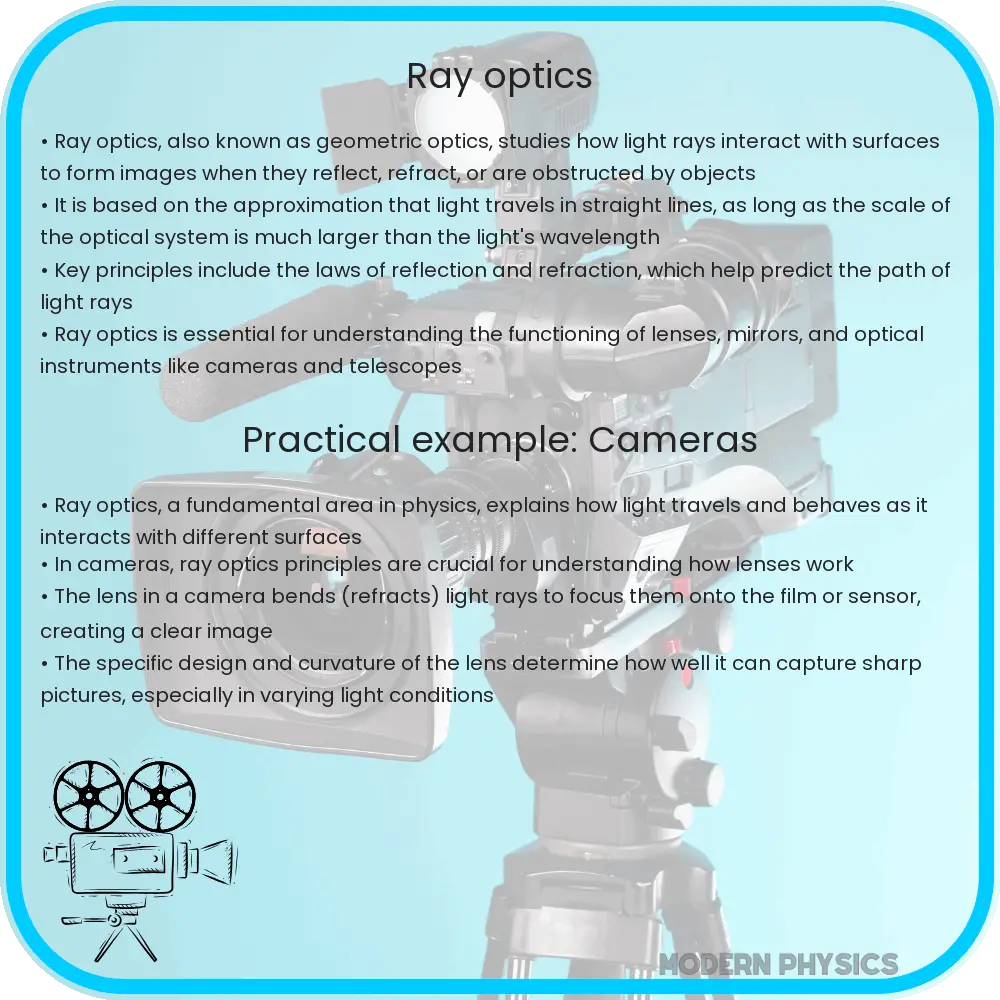Explore the principles of Ray Optics, including reflection, refraction, image formation, and their diverse applications in technology and daily life.

Introduction to Ray Optics
Ray Optics, also known as geometrical optics, is a branch of optics that deals with the propagation of light rays. This theory is based on the approximation that light travels in straight lines until it encounters a boundary between different media, such as air and glass, where it undergoes reflection or refraction. This model is highly effective in explaining and predicting optical phenomena like image formation by mirrors and lenses.
Principles of Ray Optics
The principles of ray optics are grounded in two fundamental concepts: reflection and refraction. Reflection occurs when light rays bounce off a surface, and refraction occurs when light rays bend while passing from one medium to another with different optical densities. The laws governing these phenomena are:
- Law of Reflection: The angle of incidence (the angle between the incident ray and the normal to the surface) is equal to the angle of reflection (the angle between the reflected ray and the normal).
- Snell’s Law of Refraction: This law states that the ratio of the sine of the angle of incidence to the sine of the angle of refraction is constant, depending on the refractive indices of the two media.
Image Formation by Lenses and Mirrors
In ray optics, lenses and mirrors are the primary tools for manipulating light to form images. Lenses, which are transparent materials with curved surfaces, refract light to converge or diverge rays. There are two main types of lenses:
- Convex Lenses: These lenses are thicker at the center than at the edges and converge light rays. They are used in applications such as magnifying glasses and camera lenses.
- Concave Lenses: Thinner at the center than at the edges, these lenses diverge light rays and are often used in devices like peepholes and corrective eyeglasses for myopia.
Mirrors, on the other hand, use reflection to form images. They are typically of two types:
- Plane Mirrors: These flat mirrors produce virtual images that are the same size as the object.
- Curved Mirrors: Including both concave and convex mirrors, they can produce real or virtual images, depending on the object’s position relative to the mirror.
The image formation by these optical devices is determined by the intersection of rays. In case of lenses, the principal focus and focal length play a crucial role, whereas in mirrors, it’s the mirror equation and the nature of the mirror surface.
Applications of Ray Optics
Ray optics has a wide range of applications in everyday life and advanced technology. Some of the key applications include:
- Optical Instruments: Devices such as microscopes, telescopes, and cameras rely on the principles of ray optics. Microscopes and telescopes use combinations of lenses and mirrors to magnify distant or tiny objects, while cameras use lenses to focus light and create images.
- Corrective Eyewear: Glasses and contact lenses are designed based on ray optics principles to correct vision impairments like myopia, hyperopia, and astigmatism.
- Fiber Optics: Used in telecommunications and medical imaging, fiber optics involve the transmission of light through thin, flexible fibers, relying on the principle of total internal reflection.
Advanced Concepts in Ray Optics
Beyond the basic principles, ray optics also involves advanced concepts like:
- Chromatic and Spherical Aberrations: These are distortions in images caused by lenses. Chromatic aberration occurs due to the dispersion of light, and spherical aberration is due to the shape of the lens.
- Optical Instruments Design: The design of complex optical systems, such as telescopes and cameras, involves intricate calculations and alignments of multiple lenses and mirrors to optimize image quality.
Conclusion
Ray optics, a fundamental aspect of optical science, provides a comprehensive understanding of how light interacts with different media to produce various optical phenomena. From the basic principles of reflection and refraction to the sophisticated design of optical instruments, the study of ray optics is essential in many scientific and practical applications. Its principles not only illuminate our understanding of light and vision but also drive innovation in technology, enhancing our capability to explore both the microscopic and the cosmic realms. Thus, the study of ray optics remains a vital and dynamic field, constantly evolving with technological advancements and continuing to enlighten our perception of the world around us.
